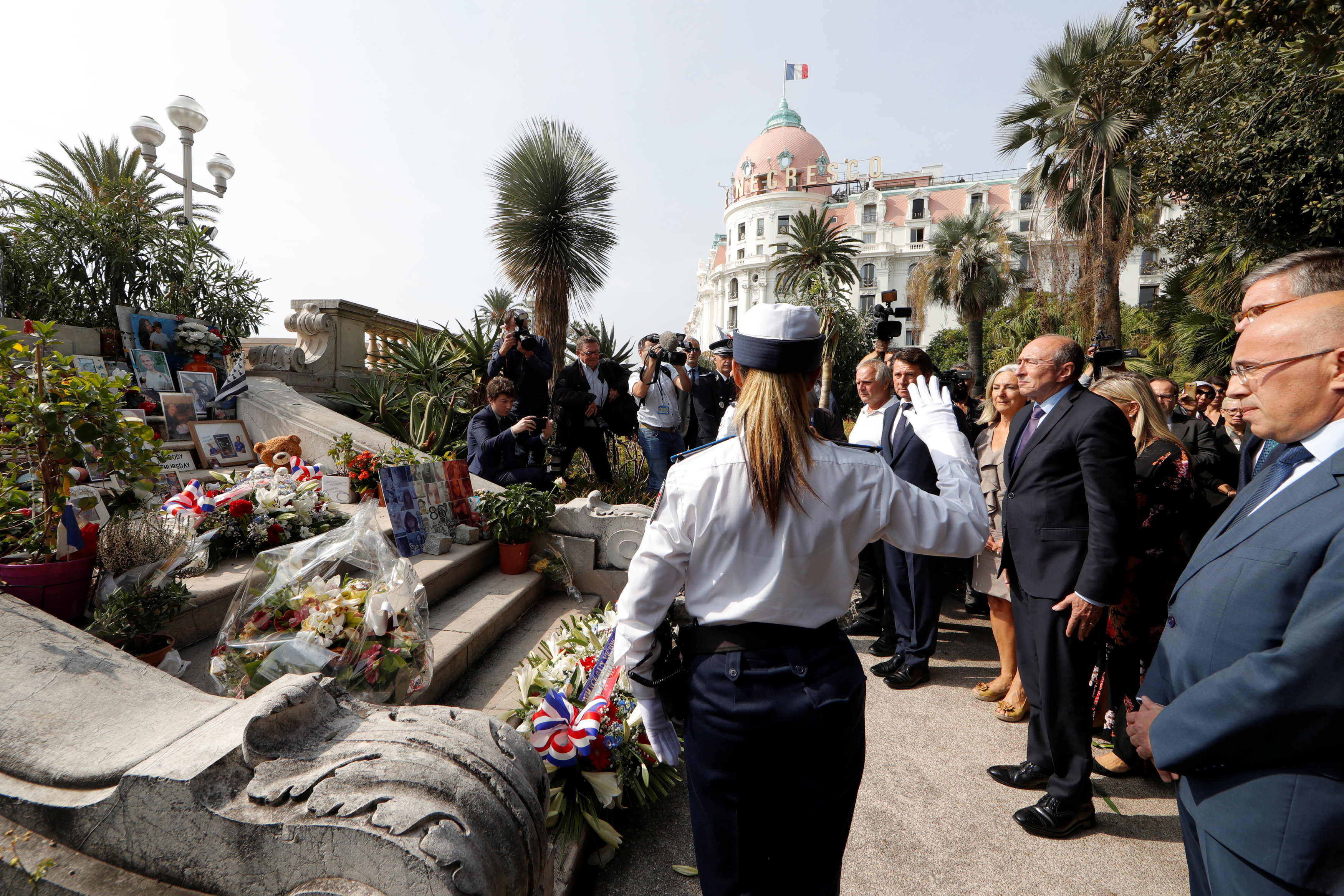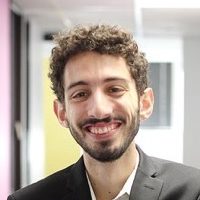 French Interior Minister Gerard Collomb and Eric Ciotti (R), President of the Departmental Council of the Alpes-Maritimes, stand at the memorial to the victims of the July 14, 2016 truck attack, in Nice, France, September 29, 2017. Collomb attends the Euro-Mediterranean conference of cities on the prevention of radicalisation and for the fight against terrorism. REUTERS/Eric Gaillard
French Interior Minister Gerard Collomb and Eric Ciotti (R), President of the Departmental Council of the Alpes-Maritimes, stand at the memorial to the victims of the July 14, 2016 truck attack, in Nice, France, September 29, 2017. Collomb attends the Euro-Mediterranean conference of cities on the prevention of radicalisation and for the fight against terrorism. REUTERS/Eric Gaillard After the July 14 attack on the Bastille Day celebration in Nice, France, one of the more quizzical pieces of internet flotsam to bubble up was a 2014 interview with Israeli Prime Minister Benjamin Netanyahu that made rounds on social media.
In a video clip, Netanyahu tells a French reporter: “If we don’t stand together, then this terror plague will come to you. It’s just a question of time. It will come to you. It will come to France.”
The words rang with eerie prescience in the wake of the latest massacre in France by a man driving a truck through a crowd of revelers in Nice, killing 84, injuring more than 200 and leaving a mile of carnage in its wake.
With Netanyahu’s prophecy a reality, Americans are facing their own troubling set of questions: Could we be next? And what can we do about it?
“We can reduce the risk but we can’t eliminate the threat, and Americans need to get used to that concept,” Erroll Southers, a USC counterterrorism expert and a consultant with the Israeli security company Tal Global, said in an interview. “Israelis are already used to that concept.”
In the aftermath of events such as the Bastille Day massacre, news viewers are used to hearing calls to harden so-called “soft” targets — unprotected civilian institutions or events with the potential for high casualties if attacked.
And, Southers told the Journal, “It always make sense to harden the targets.”
But when it comes to terrorism and counterterrorism, “It’s a cat-and-mouse game.”
“We put up a barricade; they find a way to go around it,” he said. “We implement technology; they find a way to compromise it.”
Using strategies published in Islamic State magazines, lone-wolf actors have figured out how to become “force multipliers” in terms of maximizing causalities, he said.
“The fact that an attack is successful does not mean there was a counterterrorism failure. That’s another notion we need to get rid of — these are adaptive adversaries.”
Jim Featherstone, president of the Homeland Security Advisory Council, a Los Angeles-based nonprofit that facilitates cooperation between public, private and civic sectors to advance public safety and homeland security, agreed that a successful attack does not necessarily mean a law enforcement breakdown.
“Public safety assets in this country and across the world have to be right 100 percent of the time, 365 days a year,” he told the Journal. “The terrorists only need to be right once.”
While Featherstone agreed with Southers that terrorism deaths here are unavoidable, he differed on how Americans should internalize the inevitable.
“We should work to safeguard and preserve every life,” Featherstone said. “Are there going to be some situations where that’s not going to happen? Of course — look at the events of the last few months. I don’t think it’s in the American mindset, and certainly not in the public safety mindset, that there’s an acceptable loss.”
Featherstone mentioned involving communities in their own security as one key step toward building a safer Los Angeles, citing the mantra frequently piped over airport P.A. systems: “If you see something, say something.”
The American Jewish community knows that mantra better than most, said Ariella Schusterman, associate regional director of the Anti-Defamation League (ADL) for the Pacific Southwest.
“The Jewish community is fairly sophisticated when it comes to knowing what suspicious activity looks like, or at least reporting it,” she said in an interview.
Each year, the ADL holds a briefing for local Jewish organizations on relevant security issues. On Aug. 23, it will convene community leaders to hear from San Bernardino Police Chief Jarrod Burguan on lessons from the December shooting attack at a community center there, in which 14 were killed and 22 wounded.
That massacre was the deadliest terror incident on U.S. soil since Sept. 11, 2001. It held that record for only seven months, until a man murdered 49 people and wounded at least 50 more at a gay nightclub in Orlando, Fla., in the early hours of June 12.
Ivan Wolkind, chief operating and financial officer of the Jewish Federation of Greater Los Angeles, said that in recent years, Federation has funneled increased attention and funds into the issue of keeping L.A. Jewish institutions safe.
In 2013, it launched the Community Security Initiative, which offers free security assessments, recommendations and training for its constituent organizations, employing five full-time ex-law enforcement and military personnel.
But Wolkind, a reserve L.A. Police Department officer, said vigilance should not be a reaction to a specific terrorist event, but rather a calculated response to the global threat level.
“Unless a particular attack shows a new threat we’ve never seen before, the reaction … should be nothing,” he told the Journal. “What the Jewish community and the American community should do is to recognize the fact that, unfortunately, we’re at a point where we do need to be security conscious at a constant, steady state.”
There’s a fine line between vigilance and fear.
From the “shrill and obsessive” media coverage of the violence, “people indeed can get the wrong impression that, ‘Terrorism is here and I’m going to be next,’ ” said Reuben Vaisman-Tzachor, a Santa Monica-based forensic psychologist who advised the Bush administration on the psychology of terror in the wake of 9/11.
Vaisman-Tzachor, who grew up in Israel and served as a captain in the navy there, said terror is enhanced when the culprits and their motivations are shrouded in mystery.
He pointed to the suspense thrillers of Steven Spielberg to illustrate a point about the psychology of fear: Often, the monster isn’t shown onscreen until well into the movie, a tactic used intentionally to heighten terror. The same theory that applies in “Jaws” applies to a terrorist: The devil you know is less frightening than the devil you don’t.
“Most Israelis aren’t walking around looking behind their backs and fearing that someone’s going to stab them,” he said. “There is a sense of security that doesn’t necessarily come from the fact that there is no terror. There is a sense of security because people understand exactly who are the terrorists and what are the situations they should avoid or be careful with. And so, in general, they are not living in fear.”
He added, “If there’s anything American society has to learn from, it’s that.”
And yet, the recent spate of attacks, from the ISIS-inspired shooter in Orlando to the lone-wolf sniper who slew five police officers in Dallas, is not driven by well-defined networks and clarity of purpose but by disgruntlement and social isolation, said Asli Bali, a UCLA law professor specializing in international law and arms control.
Watching the events of recent months, she said she’s noticed a “lowering of the threshold” for mental illness and disaffection to turn into staggering acts of violence. The result is not only a counterterrorism problem, but also a “multidimensional sociological problem” encompassing issues such as mental health.























 More news and opinions than at a Shabbat dinner, right in your inbox.
More news and opinions than at a Shabbat dinner, right in your inbox.